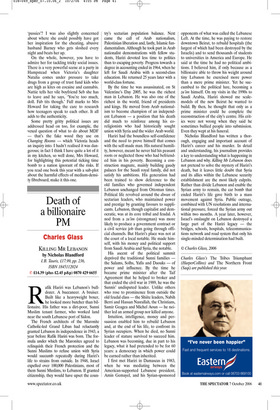Death of a billionaire PM
Charles Glass
KILLING MR LEBANON by Nicholas Blandford I.B. Tauris, £17.99, pp. 236, ISBN 1845112024 ✆ £14.39 (plus £2.45 p&p) 0870 429 6655 Rafik Hariri was Lebanon’s bulldozer. A buccaneer. A bruiser. Built like a heavyweight boxer, he looked more butcher than billionaire. His father was a dirt-poor, Sunni Muslim tenant farmer, who worked land near the south Lebanese port of Sidon.
The French architects of the Maronite Catholic-led Grand Liban had reluctantly granted Lebanon its independence in 1943, a year before Rafik Hariri was born. The formula under which the Maronites agreed to relinquish their French protection and the Sunni Muslims to refuse union with Syria would succumb repeatedly during Hariri’s life to strains from outside. In 1948, Israel expelled over 100,000 Palestinians, most of them Sunni Muslims, to Lebanon. If granted citizenship, they would have upset the coun try’s sectarian population balance. Next came the call of Arab nationalism, Palestinian liberation and, lastly, Islamic fundamentalism. Although he took part in Arab nationalist demonstrations with fellow students, Hariri devoted less time to politics than to escaping poverty. Progress towards a degree in accounting ended in 1964, when he left for Saudi Arabia with a second-class education. He returned 25 years later with a world-class fortune.
By the time he was assassinated, on St Valentine’s Day 2005, he was the richest man in Lebanon. He was also one of the richest in the world, friend of presidents and kings. He moved from Arab nationalism to become champion of an independent Lebanon — a position that his death did much to reinforce among his coreligionists who had historically sought union with Syria and the wider Arab world.
Hariri had the boundless self-confidence and the need to prove himself that comes with the self-made man. His natural humility, however, meant he never hid his peasant roots or neglected those who had befriended him in his poverty. Becoming a construction magnate, mainly building gaudy palaces for the Saudi royal family, did not satisfy his ambitions. His generation had been trained to show deference to the old families who governed independent Lebanon unchanged from Ottoman times. Political life revolved around the diwan of sectarian leaders, who maintained power and prestige by granting favours to supplicants. Lebanon, though capitalist and democratic, was at its core tribal and feudal. A nod from a za’im (strongman) was more likely to produce a government contract or a civil service job than going through official channels. But Hariri’s place was not at the court of a local notable. He made himself, with his money and political support from Saudi Arabia and Syria, the notable.
His ascent of the political summit deprived the traditional Sunni families the Salams, Solhs, Yafis and Daouks — of power and influence. By the time he became prime minister after the Taif Agreement that he helped to broker and that ended the civil war in 1989, he was the Sunnis’ undisputed leader. Unlike others who rose to prominence from outside the old feudal class — the Shiite leaders, Nabih Berri and Hassan Nasrallah, the Christians, Samir Geagea and Michel Aoun — he neither led an armed group nor killed anyone.
Intuition, intelligence, money and persuasion enabled him to rebuild Lebanon and, at the end of his life, to confront its Syrian occupiers. When he died, no Sunni leader of stature survived to succeed him. Lebanon was becoming, due in part to his legacy, what it had pretended to be for 60 years: a democracy in which power could be earned rather than inherited.
I first met Hariri in Damascus in 1983, when he was mediating between the American-supported Lebanese president, Amin Gemayel, and his Syrian-sponsored opponents of what was called the Lebanese Left. At the time, he was paying to restore downtown Beirut, to rebuild hospitals (the largest of which had been destroyed by the Israelis) and to send thousands of students to universities in America and Europe. He said at the time he had no political ambitions. I believed him, if only because as a billionaire able to throw his weight around tiny Lebanon he exercised more power than a mere prime minister. Yet he succumbed to the political lure, becoming a za’im himself. On my visits in the 1990s to Saudi Arabia, Hariri showed me scalemodels of the new Beirut he wanted to build. By then, he thought that only as a prime minister could he complete the reconstruction of the city’s centre. His critics were not wrong when they said he sometimes bullied people into submission. Even they wept at his funeral.
Nicholas Blandford has written a thorough, engaging and important account of Hariri’s career and his murder. In detail and understanding, his journalism provides a key to understanding what is happening in Lebanon and why. Killing Mr Lebanon does not pretend to solve the mystery of Hariri’s death, but it leaves little doubt that Syria and its allies within the Lebanese security establishment are the most likely culprits. Rather than divide Lebanon and enable the Syrian army to remain, the car bomb that ended Hariri’s life gave birth to a mass movement against Syria. Public outrage, combined with UN resolutions and international pressure, forced the Syrian army out within two months. A year later, however, Israel’s onslaught on Lebanon destroyed a large part of the Hariri legacy — the bridges, schools, hospitals, telecommunications network and road system that only his single-minded determination had built.


















































































 Previous page
Previous page